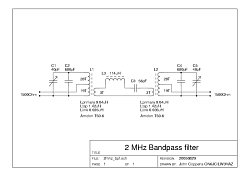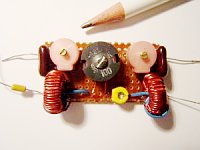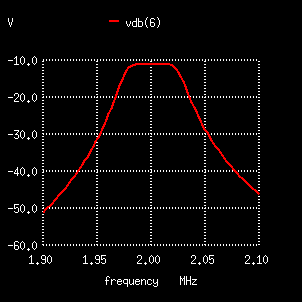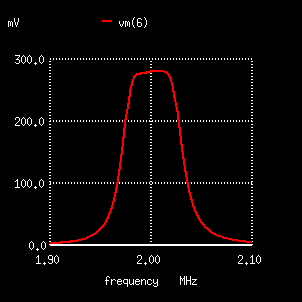2 MHz LC bandpass filter
Certainly the most critical part of the new receiver, was
(and is) the bandpass filter. After all, the idea was to reject
the interference from the OrbComm satellites. Theoretically, it
would be even impossible to do it (one of the operating frequencies
is so close to NOAA-12 that they actually overlap.
Anyway, a fairly sharp Tchebyshev filter was designed, simulated
and constructed, and, on the way, a lot was learned about LC-filters
while building. Schoolbooks is one thing, making it work quite
another...
The filter

Click on the image to obtain a larger version. There's also a PDF version of the circuit.
|
Left is the circuit of the bandpass filter. A few remarks about
strange things:
- The input and output impedance of 1500 Ω was selected
to fit the MC3356's impedances.
- The coupling between both LCs is done with a link of three
turns instead of the usual top-coupling, because of the
impracticality of the values in that case (very low Cs and
very large Ls).
- The input and output Ls could very well be tuned by compressing
the turns instead of using trimmer caps. The inductance can
be changed a few % by compression.
- The coupling LC is also tuned by a trimmer of a few pF (not
shown in the circuit).
- Keep input and output LCs separated - if too close, they will
couple directly. Even if they are toroids.
|
|
One view of the filter. The blue trimmer C tunes the
coupling section. The white thing behind the couple L is foam
double-sided adhesive tape, to fix the toroid to the wall.
|

|
|
Another view. The black trimmer Cs at each end are the
tuning caps. The brown caps are Mica 680 pF capacitors.
|

|
|
This version was constructed by Jeff, VE3AK. He commented that
the filter could not be measured using a function generator - it was
too narrow! He used a potcore for the coupling inductor (center).
|

|
Simulation

|

|
|
Filter response in dB
|
Filter response (magnitude)
|
Response of the filter, simulated with NGSpice.
8889
|
(c) John Coppens ON6JC/LW3HAZ |
mail |




